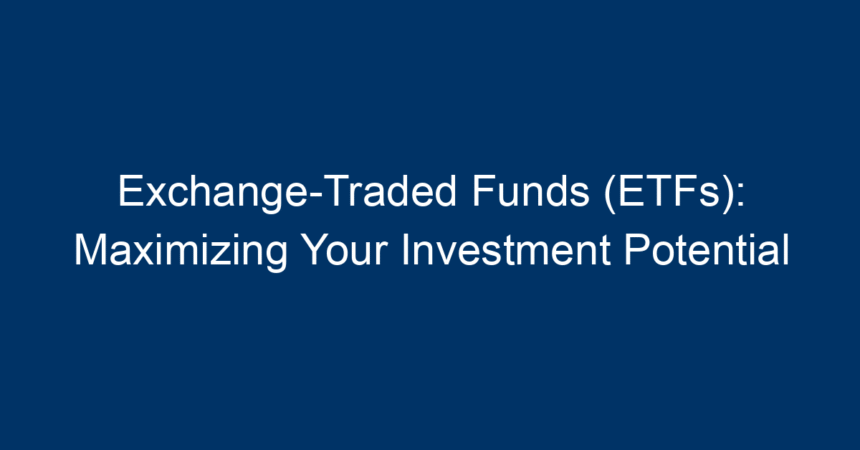In today’s fast-paced financial landscape, savvy investors are always on the lookout for effective ways to maximize their investment potential. One of the most attractive tools available is the exchange-traded fund (ETF). Offering a blend of flexibility, diversification, and cost-efficiency, ETFs provide investors with unique opportunities to grow their portfolios. This article will explore what ETFs are, how they work, their advantages, and strategies to maximize your investment potential with them.
Understanding Exchange-Traded Funds (ETFs)
To fully appreciate the benefits of exchange-traded funds (ETFs), it’s essential to understand what they are:
What Are ETFs?
Exchange-traded funds (ETFs) are investment funds that are traded on stock exchanges, much like individual stocks. They typically aim to replicate the performance of a particular index, sector, commodity, or asset class. When you invest in an ETF, you are essentially buying a share of a diversified portfolio, which can include everything from stocks and bonds to commodities and real estate.
How Do ETFs Work?
ETFs function through a combination of trading and investing. They are composed of a group of assets, and their price fluctuates throughout the trading day based on supply and demand. Investors can buy or sell shares of ETFs any time the market is open, making them highly liquid. This ability to trade throughout the day, along with their low fees and tax efficiency, has made ETFs a popular choice among individual investors and financial institutions alike.
Why Choose Exchange-Traded Funds (ETFs)?
1. Diversification
One of the foremost benefits of exchange-traded funds (ETFs) is diversification. By investing in an ETF, you can gain exposure to a wide array of assets without needing to purchase each one individually. This reduces risk and provides a buffer against market volatility. For example, rather than investing in individual stocks from different sectors, a sector-specific ETF allows you to participate in that sector’s performance.
2. Cost-Effectiveness
ETFs generally have lower expense ratios compared to mutual funds. As they are passively managed to track an index, operational costs are kept low. This means you can save on management fees, and a lower cost structure can lead to better long-term returns.
3. Flexibility and Liquidity
The ability to trade ETFs throughout the day provides investors with the flexibility to react to market changes swiftly. Unlike mutual funds, which only settle at the end of the trading day, ETFs allow for real-time buying and selling. This can be particularly advantageous during periods of market volatility.
4. Transparency
Most ETFs disclose their holdings on a daily basis, offering full transparency to investors. This feature enables you to keep track of where your money is allocated and see how well the ETF performs relative to its index.
5. Tax Efficiency
ETFs are often more tax-efficient than mutual funds because of the way transactions occur. When you sell shares of an ETF, you only realize capital gains on your investment, thus minimizing the tax impact. This is a significant advantage for long-term investors.
Strategies for Maximizing Your Investment in ETFs
While exchange-traded funds (ETFs) offer numerous benefits, it’s essential to implement effective strategies to fully maximize your investment potential. Here are several actionable insights:
1. Define Your Investment Goals
Before jumping into the ETF market, clarify your investment objectives. Are you looking for growth, income, or capital preservation? Your goals will dictate the types of ETFs you should consider. For instance:
- Growth: Consider equity ETFs that focus on sectors like technology or healthcare.
- Income: Look for bond ETFs or ETFs that focus on dividend-paying stocks.
2. Research ETF Performance
Not all ETFs are created equal. Some may underperform their respective indices or exhibit high volatility. Take the time to compare ETFs, examining their past performance, expense ratios, and the asset classes they cover. Platforms like Morningstar can provide detailed ratings and analyses.
3. Consider Asset Allocation
Strategic asset allocation is a critical component of a successful investment strategy. Diversifying your portfolio can lower risk and improve potential returns. Aim for a balanced mix of equity, fixed income, and alternative assets based on your risk tolerance and investment horizon.
4. Use Limit Orders
When trading ETFs, consider using limit orders instead of market orders. A limit order allows you to specify the price at which you’re willing to buy or sell an ETF share, providing better control over your investment.
5. Regularly Rebalance Your Portfolio
Over time, different asset classes will perform differently, leading to an imbalance in your portfolio. Regularly assess and rebalance your ETF holdings to maintain your desired asset allocation. This could involve selling off parts of an asset that has overperformed and buying more of one that has underperformed.
6. Stay Informed
Financial markets are continually evolving, and new ETFs are always being introduced. Stay updated on market trends, economic indicators, and new ETF offerings. Consider subscribing to financial news services or using investment apps that provide real-time alerts and updates.
The Future of Exchange-Traded Funds (ETFs)
The landscape of exchange-traded funds (ETFs) continues to evolve, with new innovations emerging to meet the needs of investors. Themes such as ESG (Environmental, Social, and Governance) investing, cryptocurrency-based ETFs, and smart-beta strategies are gaining traction.
Conclusion
Exchange-traded funds (ETFs) offer a powerful means of maximizing your investment potential. With their unique combination of diversification, cost-effectiveness, flexibility, and transparency, ETFs are well-suited for both novice and experienced investors alike.
To make the most of your investment strategy, define your objectives, thoroughly research ETF options, maintain a diversified portfolio, and remain informed about market trends.
As you embark on your investment journey, remember that while ETFs can be a significant tool in your arsenal, it is crucial to adopt a disciplined approach to achieve long-term financial success. By doing so, you’ll harness the true power of exchange-traded funds (ETFs) and pave the way toward a prosperous investment future.




